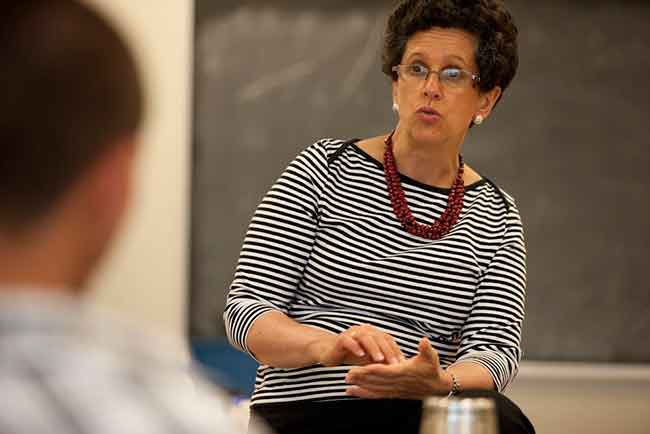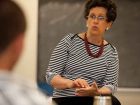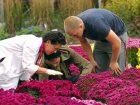
News
Inspiring the Next Generation of Industry Specialists
Olga Piedrahita looks back on a rewarding career in the classrooms, greenhouses and labs of Niagara College.
August 13, 2015 By Dave Harrison
 Olga Piedrahita, at home in classroom.
Olga Piedrahita, at home in classroom. An educator who has inspired countless horticulture students to excel in their careers has retired.
Olga Piedrahita recently stepped down after a 23-year teaching career at Niagara College.
She is known as a teacher who set high course standards, and who worked hard with students to help them achieve those goals. Graduates would comment on how knowledgeable she was about all aspects of greenhouse production, and that she was always available to assist them.
She holds a B.Sc. in entomology/plant science from the University of British Columbia and a M.Sc. in pest management/plant health from the University of Guelph.
She worked in her native Colombia as a consultant in greenhouse crops until immigrating to Canada. She was also a research associate at the Horticultural Research Institute of Ontario for several years.
During her years at Niagara College, she developed and coordinated the greenhouse technician program. She also wrote a practical insect identification guide for horticulture titled Entomology in Action for Horticulture.
GREENHOUSE CANADA: What was it that first prompted your interest in horticulture?
Olga Piedrahita: I had no idea that horticulture was a profession but I always loved the outdoors. It was not until my first year in
university, while studying to be an architect, that I realized horticulture was a field of study. I switched to agronomical engineering in my native Colombia and transferred to plant science at the University of British Columbia.
GH Where did you study at the post-secondary level, and what were some of your first jobs after graduating?
OP I had access to a calendar for the University of British Columbia. In those days they were paper copies that resembled a telephone book. It was love at first sight. Reading about all the courses I could take was like putting candy in front of a kid.
I left Colombia and moved to Vancouver to study horticulture. I graduated from UBC in plant science (1977). After graduation, I worked for a year at the university, mostly as a research technician.
I then moved to Colombia for three years and explored greenhouse vegetable and ornamental production.
In 1980, I came to Ontario to study at the University of Guelph. I graduated in 1984 with a M.Sc. in environmental biology specializing in entomology and plant health. During the summers and after graduation, I worked as a research associate at the Horticultural Research Institute of Ontario until I left the workforce to take care of my three children.
GH When did you come to Niagara College?
OP I started teaching at Niagara College in 1993. I recall Theo Blom calling on a Thursday before Labour Day and asking if I wanted to start teaching on Tuesday of the next week!
I accepted the challenge and never looked back. I fell in love with teaching right away! I continued teaching several courses with a partial load and eventually became a full-time professor in 2003.
When I started at Niagara, we had three full-time faculty and 35-40 students a year in the horticulture program. Now we have seven full-time faculty and over 220 students in three programs!
The landscape program was started in 1999 when we moved to the new campus and the greenhouse program was created in 2000-2001with a limited course offering. It was not until revising the curriculum with Mike Hoekstra in 2003-2004 that it began evolving into a greenhouse program. We had the first graduates of the revised program in 2005.
I took the lead of the greenhouse program around that time and continued to make changes on a regular basis. Since then, the program has continued to evolve to meet the changing needs of the industry.
GH What are the main courses you have taught over the years?
OP I have taught all the science courses: applied botany, soils and applied entomology. I also taught all the specialized greenhouse courses: greenhouse IPM, plant environment, rootzone management, greenhouse crops 1 and 2, and greenhouse vegetables.
We welcomed more full time staff as the programs grew and I was able to specialize in the greenhouse courses and in entomology. I taught applied entomology for 23 years to all the students in the three programs and greenhouse IPM for 12 years to the greenhouse students. Many IPM specialists in the industry started their journey with insects and pest management in those classes.
GH You have spoke at the Canadian Greenhouse Conference in the past, and will be speaking again this fall. As a preview, what will be the focus of your presentation at this year’s CGC?
OP This year’s presentations is a “Back to Basics” theme. It is an insect ID workshop that will give the participants skills to ID most insects seen in their greenhouses.
We will use mounted insects and a simplified key for hands-on activities to become familiar with the main features of the external anatomy of insects and to identify the insect to order facilitating further identification.
GH How has the Canadian greenhouse industry changed throughout your career, in terms of technologies and market challenges?
OP The greatest change has been with the advance in growing technologies. Irrigation, fertilization and IPM are areas of great change in the last few years. Increased knowledge of the plant and its environment have led to applications that increase grower control, reduce fertilizer rates by improved target application, and re-use waste water.
Other areas of change include pest management, increased biological control, improved genetics and automation.
From the business side of things, the increased regulations have become a challenge for growers in environment and labour safety issues as well as border issues. Marketing has also changed dramatically. Today’s industry is very complex and technical.
GH What are the abilities and traits of a good grower that the school is helping students develop?
OPThe main focus is developing a good technical basis with problem-solving skills that would help in the daily life of a grower. The greenhouse program is a real “boot camp” that encourages the students to think out of the box. The level of difficulty increases with each semester as the students develop the ability to think critically, look for innovation in the industry, develop applied research skills and learn to network.
The graduates from the program have good technical knowledge in areas such as IPM and fertilizer management and are encouraged to think as entrepreneurs, looking for opportunities and efficiencies.
GH What will you miss the most about teaching?
OP I will miss the regular contact with the students and alumni and the development of curriculum.
Fortunately, I have contact with many alumni that have become friends through the years.
Teaching is a rewarding profession and your efforts can be seen in the success of your alumni. It has been a total pleasure and gift to be able to work with so many passionate students through the years. They have kept me young and sharp so I could try to be ahead of their curiosity and appetite for knowledge.
GH Do you have any immediate plans with retirement? Will you be staying in touch with the industry?
OP Initially I want to take some time off to think about what is next. For sure, I get back into swimming and running regularly. I have many hobbies, so filling my time will not be difficult.
I am looking forward to spending more time with my husband, reading, painting, doing pottery, photography and travelling. I will continue to edit and expand the Applied Entomology book…and who knows what other projects will come up!
Print this page

